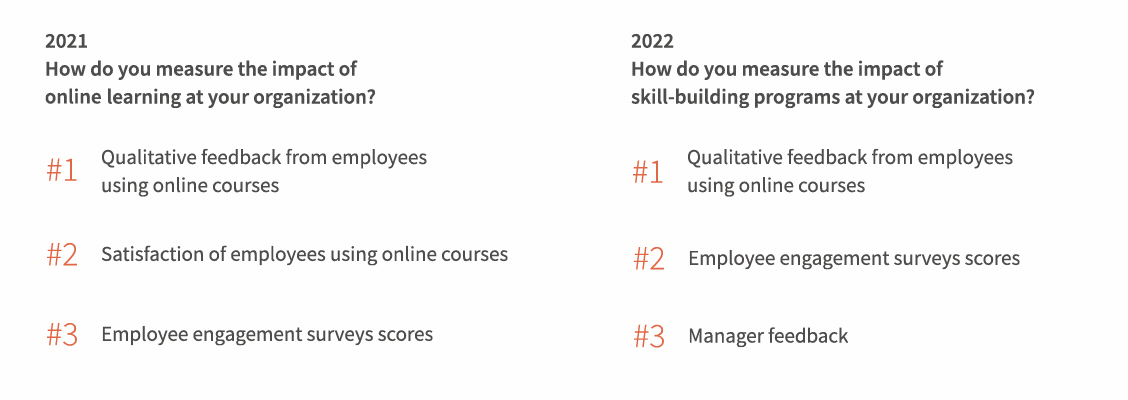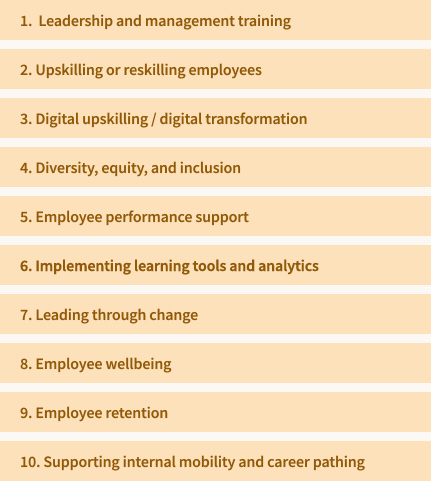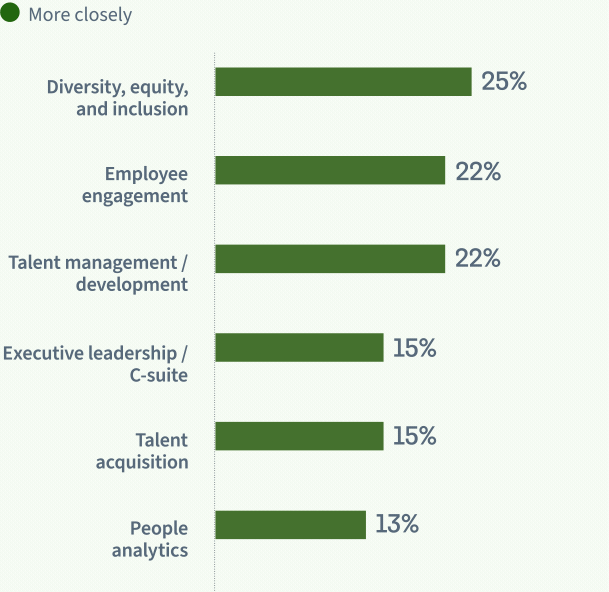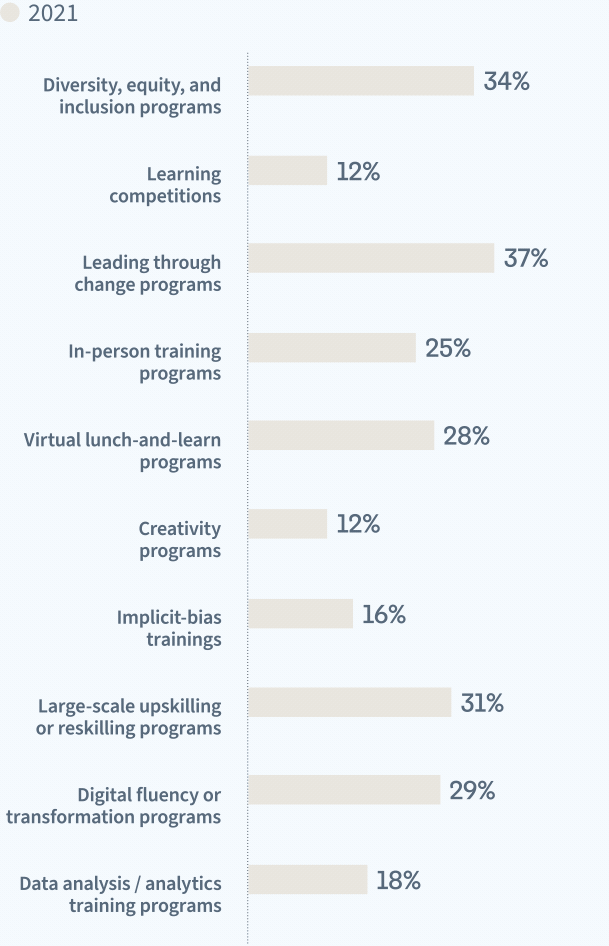2022 Workplace Learning Report

Amid an era of massive change, learning and development has a mandate to become its best self.
The transformation of learning and development (L&D) means learning leaders are knocking down traditional silos to collaborate on a more holistic vision for HR. They’re reaching for fresh solutions to tie skill building to career paths, internal mobility, and retention, while also bringing a new sense of care and humanity to employee well-being, diversity, and inclusion.
Tackling the new responsibilities of a transforming role is an enormous challenge.
This report is here to help.
Chapter 1
L&D in Transition

L&D has become more central, strategic, cross-functional — and overworked.
Learning leaders lived up to high expectations over the past two years. But one thing is clear: Their time in the spotlight is just beginning. The percentage of L&D leaders who expect to have more spending power has reached a six-year high. And their influence is growing.
Nearly three-fourths of L&D leaders agree that L&D has become more influential over the past year.


agree that L&D has become more cross-functional


agree that L&D has become a more strategic function at their organization
“It’s unsurprising that we see more and more progressive companies naming chief learning officers — as was the case with chief diversity officers when diversity was no longer an HR topic but a business advantage. Learning is not an HR topic; it’s a business topic.”
Andrew Saidy
Vice President, Global Talent, Ubisoft
L&D’s transition by the numbers

of L&D pros had some to a great deal of involvement in helping their organization adapt to change


L&D pros saw 15% more promotions this year, compared with their HR counterparts


Demand for L&D specialists increased 94% in July – September 2021, compared with April – June 2021

Whether helping their organizations adapt to change or reimagining the future, L&D pros are seizing their opportunity to lead. Now they need to figure out how to prioritize their responsibilities to stay out front.
That may be easier said than done.

Being popular has its downside
Learning leaders made clear that their 2022 workload is overwhelming. When we compared this year’s results with last year’s, we found that the number of responses for every single program we tracked year over year increased (either significantly or directionally).
L&D programs to be deployed in 2022 vs. 2021

Chapter 2
New Challenges

L&D’s rapid rise spurs new pressure to deliver results.
Learning leaders are still responsible for producing high-impact, quality learning experiences. But now they are also confronting bigger, meatier problems — like future-proofing their organizations. This will take new skills and ways of working, and a lot of prioritization.
With L&D’s to-do lists exploding, time for personal learning has fallen to the bottom.


Compared with other active learners on LinkedIn, L&D learners spent 23% less time learning in 2021


Compared with HR colleagues, L&D learners spent 35% less time learning in 2021
Finding time to learn is not a new problem. But there is new urgency around it. And while learning leaders have adapted in many ways, it’s clear there’s still some work to do.
“Make sure your learning is aligned with business skills. Rather than looking at hours of learning and course-completion rates, instead focus on identifying what skills are lacking in your organization. With that alignment and clarity, L&D can create a skill-building program that’s in lockstep with your business strategy.”
Lori Niles-Hofmann
Senior EdTech Transformation Strategist, NilesNolen


Strategic thinking requires strategic metrics
Even as L&D programs become more strategic and cross-functional, many L&D pros have not changed how they measure success. In 2022, the top way learning leaders are gauging the success of their potentially highly impactful upskilling and reskilling programs is the same way they’ve measured broader online learning programs in the past: qualitative feedback.
Measurement methods are stagnant

Challenges like upskilling an entire workforce can’t be solved with a single class — not even a really good one. This means moving beyond feedback forms and course counts. It means working collaboratively with cross-functional partners to understand the organizational impact, not just the classroom experience.
And it means aligning L&D programs with business priorities — like internal mobility and employee retention.
Chapter 3
Rethinking Skill Building

Leaders can expand impact by connecting skills to internal mobility and employee retention.
In the context of the Great Reshuffle — a period unlike anything in the history of work — organizations must prioritize enabling employees’ personal success through career development. Learning leaders can create more robust, sustainable programs by connecting skill building to career pathing, internal mobility, and retention.
“We really need to change and think about more productive and sustainable ways to help connect talent to opportunity, and our view is that that's going to be done through a skills-based approach.”
Ryan Roslansky
CEO, LinkedIn

Companies that excel at internal mobility retain employees for an average of 5.4 years, nearly twice as long as companies that struggle with it, where the average retention span is 2.9 years


Employees who feel that their skills are not being put to good use in their current job are 10 times more likely to be looking for a new job than those who feel that their skills are being put to good use


of L&D pros agree that internal mobility has become a higher priority at their organization since COVID-19

However, many L&D leaders haven’t made this connection yet. While 46% of L&D leaders said upskilling or reskilling was a top focus area this year, internal mobility and career pathing as well as employee retention fell toward the bottom.
Retention and internal mobility aren’t at the top of L&D’s to-do list.
Top 10 focus areas of 2022 L&D programs



Employees crave skills, too.
Internal mobility, career pathing, and retention are more than just rising business priorities. Career development provides a consistent and reliable reason for employees to care about, remember, and apply their new skills.
And the data supports this:
Employees’ top three motivations to learn are all connected to careers.



And that’s not all. People managers reported the top reason they recommend learning opportunities to their team members: “I want to help my direct report(s) grow in their career.”
Building long-term, synergistic career-development programs is what will move learning from a series of onetime courses to an impactful, sustainable business imperative.
Chapter 4
How L&D Succeeds

L&D pros thrive by investing in relationships, political capital, resources — and themselves.
Today’s successful L&D function needs to break out of its vertical silo and spread itself horizontally across its organization in strategic and intentional ways.
Below are the areas L&D leaders should prioritize in the coming year.
Get help from your friends
Most L&D leaders said they’ve gotten more cross-functional over the past year, but there’s a lot of room to grow. Partnering with talent acquisition is an area of opportunity as skills-based hiring becomes more important, and L&D leaders should get closer with people analytics to better understand the impact of their programs.
L&D’s cross-functional partnerships have grown year over year.

Percent of L&D partners working closely or somewhat more closely with cross-functional peers since last year
“We’re partnering with other HR functions to ensure we are ultimately facilitating a performance life cycle that fits employees’ aspirations — from talent acquisition and onboarding to overall increased engagement and thriving within an inclusive culture.”
Jodi Atkinson
Senior Director of Global Learning, Deltek

Stay close to your stakeholders
L&D leaders are twice as likely to say they have a seat at the C-suite table now, compared with during pre-pandemic times. Tying learning programs to business impact based on key organizational priorities, like internal mobility, will be crucial in maintaining this seat in the future.
The percentage of L&D pros who agree that L&D has a seat at the executive table continues to grow:



Go big with budget
Nearly half of L&D pros expect their budgets to increase this year. This is great news given the amount of work L&D is being asked to do. Now L&D leaders need to be smart about how they use the money. Learning pros should consider outsourcing more manual and administrative tasks, freeing up time to dig into the areas that drive business impact.
* Note that past surveys included more granular categories of budget increases. This year’s question simply asked whether L&D pros expect their budget to increase, decrease, or remain the same.
The percentage of L&D leaders who expect to have more spending power has reached a six-year high.*


The Takeaway

“Once the curators, designers, and executors of learning content and curriculum, L&D is primed to evolve as the connector of people, resources, and experiences that provide continuous growth and success for the employee. From onboarding to career development to exit, L&D will merge business needs with employee needs and create relevant ways for employees to stretch themselves daily throughout their entire career.”
Alyson DeMaso
Founder and CEO, Raising Beauty

A Global Perspective

Ready for the deep dive?
We’ve only scratched the surface. Download the full report for additional survey data, further commentary and context, and a host of extras.

Level up your learning programs with our skill building platform
As you know, learning is leading the way this year. Chat with a learning consultant to find the best solution for your team and learn more about our promotional offer on LinkedIn Learning Hub.

Contact Sales

Methodology
Using an internal LinkedIn sample, we surveyed 1,444 L&D Professionals and 610 Learners in November 2021 in English, French, German, and Portuguese. The full list of places we surveyed includes the US, Canada, Brazil, the UK, Ireland, Belgium, the Netherlands, Luxembourg, France, Germany, Austria, Norway, Finland, Sweden, Iceland, Denmark, Australia, New Zealand, India, Cambodia, Indonesia, Singapore, the Philippines, Malaysia, Myanmar, Thailand, and Hong Kong. We also collected self-reported data from an internal LinkedIn sample of over 2,000 LinkedIn members in November and December 2021. For the full methodology, please see the PDF report.









